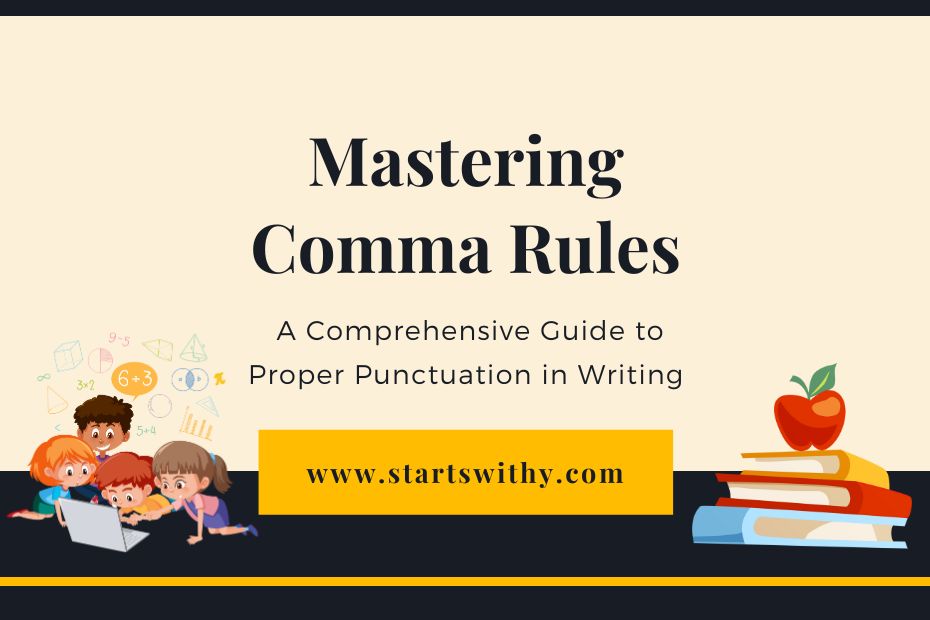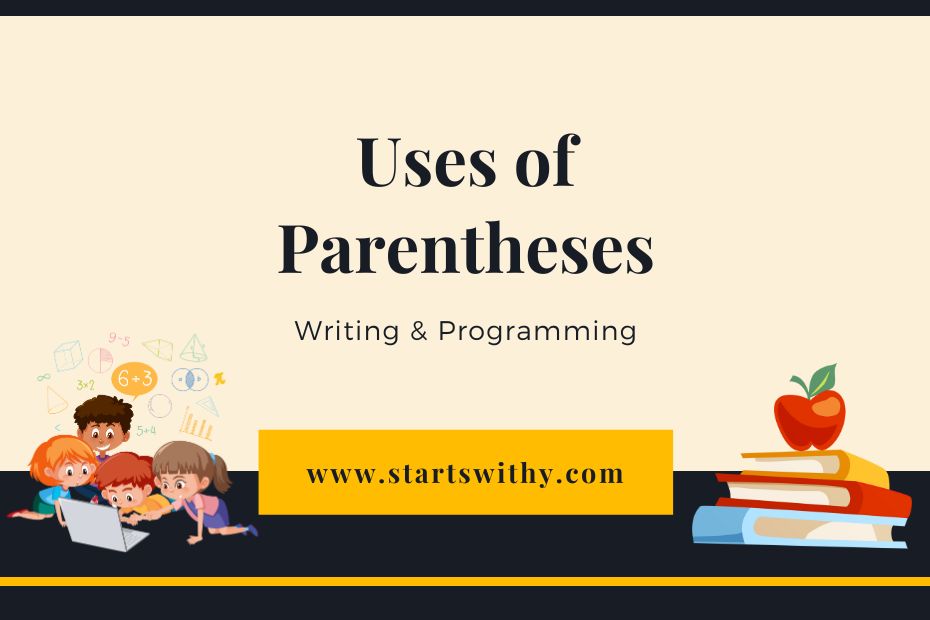Are you tired of feeling confused about when and where to use commas? You’re not alone. The comma is a punctuation mark that is often misused, leading to confusion and frustration. But fear not! In this article, I’ll guide you through the ins and outs of comma rules, making it easier than ever to master this essential punctuation mark.
Comma rules may seem complicated, but they can actually be quite simple once you understand the four distinct uses of the comma. Forget everything you’ve been told about pausing or using commas wherever you feel like it. That advice is misleading. Instead, we’ll explore the listing comma, the joining comma, the gapping comma, and the bracketing commas. Each use has its own set of rules, and by the end of this article, you’ll have a clear understanding of when and how to use commas correctly.
So, whether you’re a student struggling with essay writing or a professional looking to polish your communication skills, mastering comma rules is essential. By understanding the purpose behind using commas, you’ll be able to confidently navigate introducers, interrupters, and addons in your writing. Get ready to take your punctuation game to the next level as we dive into the world of comma rules.
The Importance of Comma Rules
As a writer, understanding and applying proper comma rules is crucial for effective communication. Properly used commas help to clarify meaning, improve readability, and prevent confusion. Let’s explore why mastering comma rules is essential for both students and professionals.
Enhancing Clarity and Meaning
Mastering comma rules allows writers to convey their intended meaning clearly and concisely. Commas help to signal pauses, separate ideas, and indicate relationships between words or phrases within a sentence. They act as a guide, helping readers to navigate through the text smoothly without having to backtrack or decipher the writer’s intention.
Improving Readability
By using commas correctly, writers can greatly enhance the readability of their work. Commas help to break up long, complex sentences, making them easier to follow and comprehend. They create a natural flow, allowing readers to process information in a logical manner. Without proper comma usage, sentences can become convoluted and challenging to understand.
Promoting Professionalism
For professionals, such as those in the fields of journalism, content writing, or business communication, mastering comma rules is essential. Poor comma usage can lead to misunderstandings, misinterpretations, and a lack of credibility. On the other hand, demonstrating a solid understanding of proper comma usage showcases professionalism and attention to detail in writing.
Developing Strong Writing Skills
Mastering comma rules is not just about following a set of arbitrary guidelines; it is about developing strong writing skills. By understanding and applying proper comma usage, writers can improve their overall writing abilities. They can create more cohesive, coherent, and engaging pieces that captivate readers and effectively convey their ideas.
Comma rules play a vital role in effective communication and writing. By understanding the importance of mastering these rules, writers can enhance clarity, improve readability, promote professionalism, and develop strong writing skills. So, let’s dive into the various comma rules and learn how to use them effectively in our writing.
Basic Comma Rules
Using a comma to separate items in a list
One of the most common uses of a comma is to separate items in a list. When you have a list that contains more than two elements, use commas to separate them.
Example: Julie loves ice cream, books, and kittens.
Using a comma to separate independent clauses in a sentence
Another important use of a comma is to separate independent clauses in a sentence. An independent clause is a group of words that can stand alone as a complete sentence. When you join two independent clauses with a coordinating conjunction (and, but, for, or, nor, so, yet), use a comma before the conjunction.
Example: I love vanilla ice cream, but my brother prefers chocolate.
Using a comma after introductory words or phrases
Commas are also used after introductory words or phrases that come before the main clause. These words or phrases are called “introductory elements.” Introductory elements can be words, phrases, or clauses that provide additional information at the beginning of a sentence.
Example: In the beginning, there was light.
Using a comma before conjunctions in compound sentences
Commas are used before conjunctions (and, but, for, or, nor, so, yet) when they are used to connect two independent clauses in a compound sentence. This helps to clarify the separation between the two independent clauses.
Example: Hilda, a very good cook, went to San Francisco.
By understanding and applying these basic comma rules, you can improve the clarity and readability of your writing. Remember to check your writing for these comma uses and practice incorporating them into your sentences. The proper use of commas can enhance your communication skills and elevate the quality of your writing.
Advanced Comma Rules
Using a comma with non-essential information
When it comes to using commas, it’s important to understand how they can be used with non-essential information in a sentence. Non-essential information is extra or additional information that is not necessary for the sentence to make sense.
For example: “My father-in-law, in a quest for the perfect rack of ribs, purchased a $10,000 Swiss-made barbecue.”
In this sentence, the phrase “in a quest for the perfect rack of ribs” is non-essential because it doesn’t change the main point of the sentence, which is that my father-in-law spent too much on his grill.
To separate non-essential information from the rest of the sentence, you can use a pair of commas or a single comma. However, be sure not to forget the commas when adding extraneous details, as they help improve readability and grammar.
Using a comma with appositives
Appositives are words or phrases that provide additional information about a noun. When using appositives in a sentence, it’s important to separate them with commas.
For example: “My best friend, Joe, arrived.”
In this sentence, the word “Joe” is an appositive that provides additional information about the noun “friend.” By using a comma before and after the appositive, we indicate that it is not essential to the sentence but adds more context.
Similarly, when there are multiple appositives, each one should be separated by commas.
For example: “The three items, a book, a pen, and paper, were on the table.”
In this sentence, each appositive (a book, a pen, and paper) provides additional information about the noun “items.” Commas are used to separate each appositive and improve clarity.
Using a comma with direct address
When directly addressing someone in a sentence, it’s important to use commas to set off their name or title.
For example: “Will you, Aisha, do that assignment for me?”
In this sentence, the name “Aisha” is directly addressed, and a comma is used before and after the name to indicate that it is being set off from the rest of the sentence.
Similarly, if you are addressing someone using a title or term of endearment, commas should also be used for clarity.
For example: “Good day, Captain!”
In this sentence, the title “Captain” is directly addressed, and a comma is used before and after the title to set it off.
Using a comma with dates and addresses
Proper comma usage is also important when dealing with dates and addresses.
To separate the day of the month from the year, a comma is used.
For example: “It was in The Sun’s June 5, 2019, edition.”
In this sentence, a comma is used to separate the day of the month (June 5) from the year (2019).
Similarly, when separating a city from its state, a comma is used.
For example: “I’m from the Akron, Ohio, area.”
In this sentence, a comma is used to separate the city (Akron) from the state (Ohio).
Remember, using commas correctly in dates and addresses helps improve clarity and ensure proper understanding of the information being conveyed.
By understanding and applying these advanced comma rules, writers can enhance the clarity, readability, and overall effectiveness of their writing.
Common Comma Mistakes to Avoid
Avoiding the comma splice
One of the most common comma mistakes to avoid is the comma splice. A comma splice occurs when two independent clauses are joined together with just a comma, without a coordinating conjunction or appropriate punctuation. This can make the sentence unclear or awkward. To fix a comma splice, you can:
- Add a coordinating conjunction (e.g., and, but, or) after the comma to join the clauses.
- Change the comma to a semicolon to separate the clauses.
- Make each clause a separate sentence.
- Add a subordinator (e.g., because, although) to one of the clauses to make it dependent.
For example:
- Incorrect: We didn’t have any milk, I went to the shop.
- Correct: We didn’t have any milk, so I went to the shop.
Avoiding unnecessary commas
Another mistake to avoid is using unnecessary commas. While commas are necessary in certain situations, they should not be used indiscriminately. Here are a few instances where you should avoid using unnecessary commas:
- Between two nouns that appear together as a compound subject or compound object. For example: Incorrect: Daryl and his teammates will be going to Derby on Wednesday. Correct: Daryl and his teammates will be going to Derby on Wednesday.
- After a long or complex subject. For example: Incorrect: The things that cause me joy, may also cause me pain. Correct: The things that cause me joy may also cause me pain.
- When listing only two items. For example: Incorrect: I like apples, oranges, and bananas. Correct: I like apples, oranges and bananas.
Avoiding misused commas
Misused commas can also hinder the clarity of a sentence. Here are a few examples of misused commas to avoid:
- Placing a comma between a subject and its verb. While speakers may pause at this point in a sentence, in writing, it only makes the sentence seem stilted. For example: Incorrect: My friend Cleo, is a wonderful singer. Correct: My friend Cleo is a wonderful singer.
- Misplacing commas in introductory phrases. If the phrase is clear and brief (three or four words), the comma is optional. However, always add a comma if it would avoid confusion. For example: Optional comma: When in town, we go shopping. Necessary comma: Last Sunday, evening classes were canceled.
Avoiding inconsistent comma usage
Consistency is key when it comes to comma usage. Make sure to use commas consistently within a sentence or paragraph. Inconsistency can lead to confusion or ambiguity. Pay attention to the following:
- Using commas consistently with nonrestrictive clauses. Nonrestrictive clauses offer additional information but aren’t essential for identifying the thing being talked about. They should be set off by commas. For example: Nonrestrictive clause: Posey’s Cafe, which Chester recommended, is a fantastic restaurant.
- Remembering that comma usage can change the meaning of a sentence. Use commas consistently to convey the intended meaning. For example: With comma: The relentless, powerful summer sun beat down on them. Without comma: The relentless powerful summer sun beat down on them.
By avoiding these common comma mistakes and using commas appropriately and consistently, you can enhance the clarity, readability, and overall effectiveness of your writing.
Conclusion
Understanding and applying proper comma rules is crucial for effective communication and writing. By using commas correctly, writers can enhance the clarity, readability, and overall effectiveness of their writing. In this article, we explored basic comma rules, such as separating items in a list, separating independent clauses, and using commas after introductory words or phrases. We also delved into advanced comma rules, including using commas with non-essential information, appositives, direct address, and dates and addresses.
Additionally, we discussed common comma mistakes to avoid, such as comma splices, unnecessary commas, misused commas, and inconsistent comma usage. By being aware of these mistakes and making the necessary corrections, writers can further improve the quality of their writing.
Remember, mastering comma rules takes practice and attention to detail. By consistently applying proper comma usage, you can ensure that your writing is clear, concise, and professional. So, keep these comma rules in mind and watch your writing skills soar!



